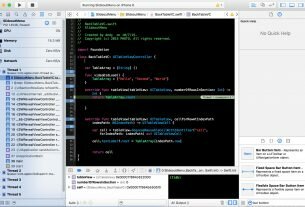Question or problem in the Swift programming language:
I have seen this code in other post, for save pictures:
// Create path. NSArray *paths = NSSearchPathForDirectoriesInDomains(NSDocumentDirectory, NSUserDomainMask, YES); NSString *filePath = [[paths objectAtIndex:0] stringByAppendingPathComponent:@"Image.png"]; // Save image. [UIImagePNGRepresentation(image) writeToFile:filePath atomically:YES];
An d I’m trying convert to swift for save a picture take with avfoundatioin but I dont know type NSDocumentDirectory and NSUserDomainMask here
How can convert this??
Thanks!!
How to solve the problem:
Solution 1:
As follows:
let nsDocumentDirectory = NSSearchPathDirectory.DocumentDirectory
let nsUserDomainMask = NSSearchPathDomainMask.UserDomainMask
if let paths = NSSearchPathForDirectoriesInDomains(nsDocumentDirectory, nsUserDomainMask, true) {
if paths.count > 0 {
if let dirPath = paths[0] as? String {
let readPath = dirPath.stringByAppendingPathComponent("Image.png")
let image = UIImage(named: readPath)
let writePath = dirPath.stringByAppendingPathComponent("Image2.png")
UIImagePNGRepresentation(image).writeToFile(writePath, atomically: true)
}
}
}
“paths” is an AnyObject[], so you have to check that its elements can be converted to String.
Naturally, you wouldn’t actually use “NSDocumentDirectory” as the name, I just did it for clarity.
Update for Xcode 7.2
NSSearchPathForDirectoriesInDomains now returns [String] rather than [AnyObject]? so use
let nsDocumentDirectory = NSSearchPathDirectory.DocumentDirectory
let nsUserDomainMask = NSSearchPathDomainMask.UserDomainMask
let paths = NSSearchPathForDirectoriesInDomains(nsDocumentDirectory, nsUserDomainMask, true)
if let dirPath = paths.first {
// ...
}
The fact that .stringByAppendingPathComponent is also deprecated is dealt with in this answer…
Solution 2:
Here is what I use:
let fileManager = NSFileManager.defaultManager()
let nsDocumentDirectory = NSSearchPathDirectory.DocumentDirectory
let nsUserDomainMask = NSSearchPathDomainMask.UserDomainMask
let documentsURL = fileManager.URLsForDirectory(nsDocumentDirectory, inDomains: nsUserDomainMask).last
Solution 3:
This is just a rework of @पवन answer working for Swift 3
import Foundation
import UIKit
import ImageIO
import MobileCoreServices
extension UIImage
{
func write(at path:String) -> Bool
{
let result = CGImageWriteToFile(image: self.cgImage!, filePath: path)
return result
}
private func CGImageWriteToFile(image:CGImage, filePath:String) -> Bool
{
let imageURL:CFURL = NSURL(fileURLWithPath: filePath)
var destination:CGImageDestination? = nil
let ext = (filePath as NSString).pathExtension.lowercased()
if ext == "jpg" || ext == "jpeg"
{
destination = CGImageDestinationCreateWithURL(imageURL, kUTTypeJPEG, 1, nil)
}
else if ext == "png" || ext == "pngf"
{
destination = CGImageDestinationCreateWithURL(imageURL, kUTTypePNG, 1, nil)
}
else if ext == "tiff" || ext == "tif"
{
destination = CGImageDestinationCreateWithURL(imageURL, kUTTypeTIFF, 1, nil)
}
else if ext == "bmpf" || ext == "bmp"
{
destination = CGImageDestinationCreateWithURL(imageURL, kUTTypeBMP, 1, nil)
}
guard destination != nil else {
fatalError("Did not find any matching path extension to store the image")
}
CGImageDestinationAddImage(destination!, image, nil)
if CGImageDestinationFinalize(destination!)
{
return true
}
return false
}
}
And the usage
let pickedImage = UIImage()
let path = (NSSearchPathForDirectoriesInDomains(.documentDirectory, .userDomainMask, true).first! as NSString).appendingPathComponent("image.tif")
if pickedImage.write(at: path) == false
{
print("failed to write file to disk!")
}
Solution 4:
Use this category to save any image on document directory
import Foundation
import UIKit
import ImageIO
import MobileCoreServices
extension UIImage {
func writeAtPath(path:String) -> Bool {
let result = CGImageWriteToFile(self.CGImage!, filePath: path)
return result
}
private func CGImageWriteToFile(image:CGImageRef, filePath:String) -> Bool {
let imageURL:CFURLRef = NSURL(fileURLWithPath: filePath)
var destination:CGImageDestinationRef? = nil
let ext = (filePath as NSString).pathExtension.uppercaseString
if ext == "JPG" || ext == "JPEG" {
destination = CGImageDestinationCreateWithURL(imageURL, kUTTypeJPEG, 1, nil)
} else if ext == "PNG" || ext == "PNGF" {
destination = CGImageDestinationCreateWithURL(imageURL, kUTTypePNG, 1, nil)
} else if ext == "TIFF" || ext == "TIF" {
destination = CGImageDestinationCreateWithURL(imageURL, kUTTypeTIFF, 1, nil)
} else if ext == "GIFF" || ext == "GIF" {
destination = CGImageDestinationCreateWithURL(imageURL, kUTTypeGIF, 1, nil)
} else if ext == "PICT" || ext == "PIC" || ext == "PCT" || ext == "X-PICT" || ext == "X-MACPICT" {
destination = CGImageDestinationCreateWithURL(imageURL, kUTTypePICT, 1, nil)
} else if ext == "JP2" {
destination = CGImageDestinationCreateWithURL(imageURL, kUTTypeJPEG2000, 1, nil)
} else if ext == "QTIF" || ext == "QIF" {
destination = CGImageDestinationCreateWithURL(imageURL, kUTTypeQuickTimeImage, 1, nil)
} else if ext == "ICNS" {
destination = CGImageDestinationCreateWithURL(imageURL, kUTTypeAppleICNS, 1, nil)
} else if ext == "BMPF" || ext == "BMP" {
destination = CGImageDestinationCreateWithURL(imageURL, kUTTypeBMP, 1, nil)
} else if ext == "ICO" {
destination = CGImageDestinationCreateWithURL(imageURL, kUTTypeICO, 1, nil)
} else {
fatalError("Did not find any matching path extension to store the image")
}
if (destination == nil) {
fatalError("Did not find any matching path extension to store the image")
return false
} else {
CGImageDestinationAddImage(destination!, image, nil)
if CGImageDestinationFinalize(destination!) {
return false
}
return true
}
}
}
// This is how to use this category in your application.
func testImageWrite() -> Bool {
let img = UIImage(named: "test")
var path = NSSearchPathForDirectoriesInDomains(NSSearchPathDirectory.DocumentDirectory, NSSearchPathDomainMask.UserDomainMask, true)[0]
path = (path as NSString).stringByAppendingPathComponent("Test.png")
let result = img?.writeAtPath(path)
return result!
}
Solution 5:
For xCode 8.1, swift 3.0 you can do:
let path = NSSearchPathForDirectoriesInDomains(.documentDirectory, .userDomainMask, true).first!
I think this is a lot cleaner and shorter.



